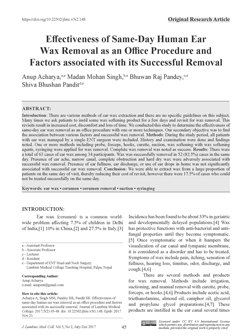Effectiveness of Same-Day Human Ear Wax Removal as an Office Procedure and Factors Associated with its Successful Removal
Keywords:
ear wax, cerumen, cerumen removal, suction, syringingAbstract
Introduction: There are various methods of ear wax extraction and there are no specific guidelines on this subject. Many times we ask patients to instil some wax softening product for a few days and revisit for wax removal. These revisits result in increased cost, discomfort and loss of time. We conducted this study to determine the effectiveness of same-day ear wax removal as an office procedure with one or more techniques. Our secondary objective was to find the association between various factors and successful wax removal.
Methods: During the study period, all patients with ear wax managed by a single ENT surgeon were included. History and examination were done and findings noted. One or more methods including probe, forceps, hooks, curette, suction, wax softening with wax softening agents, syringing were applied for wax removal. Complete wax removal was noted as success.
Results: There were a total of 63 cases of ear wax among 34 participants. Wax was successfully removed in 52 (82.5%) cases in the same day. Presence of ear ache, narrow canal, complete obstruction and hard dry wax were adversely associated with successful wax removal. Presence of ear fullness, ear discharge, or use of ear drops in home was not significantly associated with successful ear wax removal.
Conclusion: We were able to extract wax from a large proportion of patients on the same day of visit, thereby reducing their cost of revisit, however there were 17.5% of cases who could not be treated successfully on the same day.
Downloads

Downloads
Published
How to Cite
Issue
Section
License
The Journal of Lumbini Medical College (JLMC) publishes open access articles under the terms of the Creative Commons Attribution(CC BY) License which permits use, distribution and reproduction in any medium, provided the original work is properly cited.JLMC requires an exclusive licence allowing to publish the article in print and online.
The corresponding author should read and agree to the following statement before submission of the manuscript for publication,
License agreement
In submitting an article to Journal of Lumbini Medical College (JLMC) I certify that:
- I am authorized by my co-authors to enter into these arrangements.
- I warrant, on behalf of myself and my co-authors, that:
- the article is original, has not been formally published in any other peer-reviewed journal, is not under consideration by any other journal and does not infringe any existing copyright or any other third party rights;
- I am/we are the sole author(s) of the article and have full authority to enter into this agreement and in granting rights to JLMC are not in breach of any other obligation;
- the article contains nothing that is unlawful, libellous, or which would, if published, constitute a breach of contract or of confidence or of commitment given to secrecy;
- I/we have taken due care to ensure the integrity of the article. To my/our - and currently accepted scientific - knowledge all statements contained in it purporting to be facts are true and any formula or instruction contained in the article will not, if followed accurately, cause any injury, illness or damage to the user.
- I, and all co-authors, agree that the article, if editorially accepted for publication, shall be licensed under the Creative Commons Attribution License 4.0. If the law requires that the article be published in the public domain, I/we will notify JLMC at the time of submission, and in such cases the article shall be released under the Creative Commons 1.0 Public Domain Dedication waiver. For the avoidance of doubt it is stated that sections 1 and 2 of this license agreement shall apply and prevail regardless of whether the article is published under Creative Commons Attribution License 4.0 or the Creative Commons 1.0 Public Domain Dedication waiver.
- I, and all co-authors, agree that, if the article is editorially accepted for publication in JLMC, data included in the article shall be made available under the Creative Commons 1.0 Public Domain Dedication waiver, unless otherwise stated. For the avoidance of doubt it is stated that sections 1, 2, and 3 of this license agreement shall apply and prevail.
Please visit Creative Commons web page for details of the terms.



